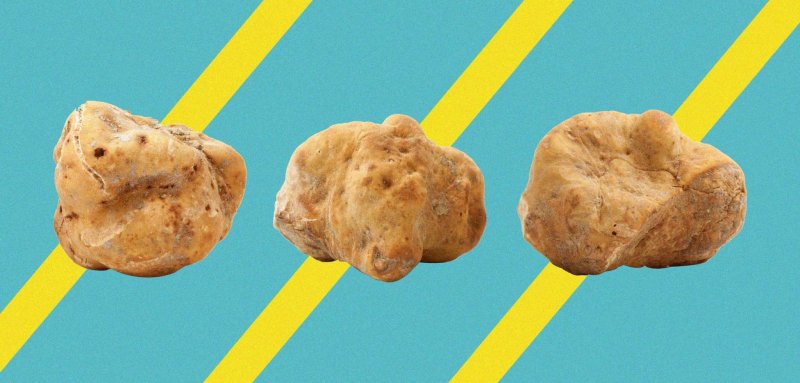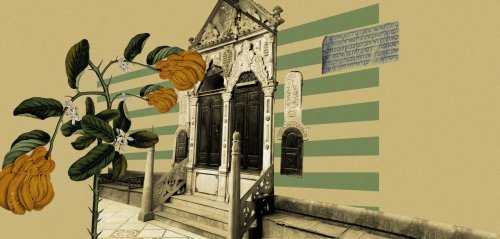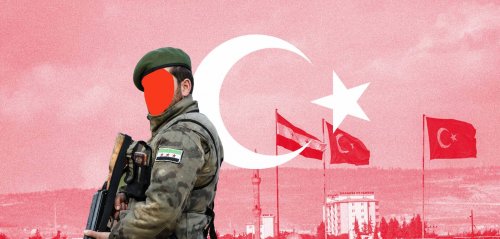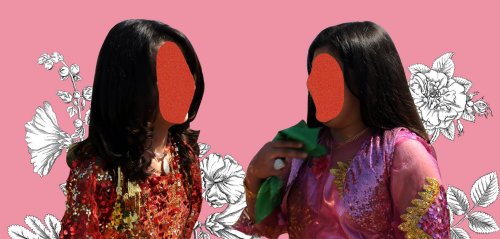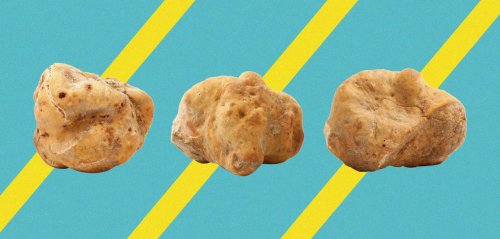“Kama for 500, Kama for 500" in loud lilting voices the vendors of Souq Al-Wadi, in the centre of Deir Ezzor, in the east of Syria try to sell this popular seasonal produce- known locally as Kama or desert truffle.
This season has been particularly good "the country has not seen such abundance in decades" according to the stall vendors and shop owners who consider truffles "a gift of heaven and the sky was generous this year."
In the vast bustling market abundant with fruit, meat, fish and sweets shops you can also see large baskets full of Kama, which is found in mostly desert areas after rainfall. It is one of the most protein rich and fatty fungi so much so that locals liken it to red meat. The price of truffles range from 500 Syrian pounds (one dollar) to 6,000 pounds per kilogram, depending on their color and size, which differ according to the type of soil in which the truffle grows.
This year’s truffle season has been particularly good: "Syria has not seen such abundance in decades" according to the stall vendors and shop owners who consider truffles "a gift of heaven and the sky was generous this year."
It is the first time in years that people resumed truffle picking due to the wars which where truffles grow. From the desert, the truffles are transferred to Deir Ezzor and then to the more distant Syrian cities.

Truffles ... Types and shapes
The sellers distinguish between the small brown truffle, which is called "Harqa” which is no larger than a walnut and "Zubaidiyah" which are of larger size and lighter color, and the "Sheikh" which are so named because they supposedly resemble an old man’s fluffy white beard and are roughly the size of a large potato.
"The price is according to size, quality and taste," explains the elderly vendor to a woman approaching him and asking for details and prices, he boastfully shows off the breadth of his knowledge "the Kama of the Levant meaning west of the Euphrates is different from the Kama east of the river in the peninsula, the dark one is soft and melts in your mouth, while the Zubadiya is delicious but quite different" he adds laughingly "you can say the dark one is like beef and the paler one is more like veal".

The Truffle’s journey from the desert to the markets
The truffle grows in the desert or semi-desert regions of Syria and other countries of the Middle East and the Mediterranean. It is a type of fungus that does not need seeds for growth and often appears alongside some desert plants or near the roots of the trees, at a depth of 5 to 15 cm. The truffle only grows during rainy seasons, especially when thunder and lightning occur. Lightning contributes to the interaction of certain components and biological residues in the soil, including salts and minerals, to form truffles of different types and sizes (there are roughly 30 species depending on where you look) and people living near these areas go search for truffles every rainy night, they have many different names for the truffle like "daughter of thunder" and "thunder plant".
Along the road between the city of Damascus and Deir Ezzor in eastern Syria, especially in the desert areas, dozens of people are looking for truffles between the soil and grass they can tell where it is because of the formations on the surface of the soil, or the presence of a particular kind of flowers near it or even sometimes if certain insects hover nearby.
Deir Ezzor locals and the inhabitants of other villages spend long hours hand picking truffles, or using some simple metal tools to dig for them. It is the first time in years that people have resumed this activity due to the wars which raged for years in the areas where truffles grow.

From the desert, the truffles are transferred to Deir Ezzor, to nearby cities and villages, and on to the more distant Syrian cities, to be sold in different markets at varying prices, starting from 500 lira (one dollar) per kilogram in the markets of Deir Ezzor and can cost up to 8000 Lira in the more upscale markets of Damascus, and these are cheap prices compared with the less rainy past years in which the price of Kama skyrocketed to $50 per kilo.
50 year old Abu Ali explains: ”There is no specific rule to determine the price of truffles, it only costs the human effort required to collect and transport them to the markets," referring to the price of truffles, based mainly on how abundant the season was and how high the demand The price varies from market to market. Here in Deir Ezzor prices are lowest, and it gets higher when we move to other cities, and can vary even within the same city according to the market and whether it is popular or not."

However, the margin of profit for those who collect truffles may not exceed 15% of the price and it has a season from late October to late April. Truffle picking cannot be relied upon as a basic source of income, but it has contributed in recent months to the aid of dozens of families who have lost their livelihoods due to war and economic devastation in the country.
The search for truffles is not without risk, as local Syrian media reported dozens of farmers dying from landmines while looking for truffles in battle sites.
Rituals and beliefs
Since it mostly proliferates in the desert, Kama is very special to people from Syria’s East and they have their own beliefs and rituals relating to the fungi.
"The season of Kama is a season for blood," says Abu Ali, with a chilling voice. "This is the story of our grandmothers, where it is believed here in Deir Ezzor that the year when the truffle grows abundantly is a bad omen.” He then smiles adding: “Grandmothers, did not predict the war in the country, and has there been any season of blood worse than what we have experienced in the last few years? We still eat Kama and fear possible coming evils”.

This belief prompts some women to throw the water used to wash the truffles in front of the homes of neighbours they hate, this would often cause fights, as it's a sort of malediction or curse or so people of the city believe.
Despite these beliefs and tales, eating truffles in Deir Ezzor prior to the outbreak of the war was like a celebration. Most families used to go out on sunny days after rain outside the city to collect truffles and barbecue them: "In the past, the desert was full of the smell of food cooking and people every Thursday and Friday," said Reem a resident of Deir Ezzor adding sadly: "Indeed they were unforgettable days."

Secrets of preparing truffles
In Deir Ezzor, there are dozens of different ways to prepare truffles, such as roasting them, cooking them with rice or with Arabic ghee, frying them with eggs, stuffing them with rice and meat or even cut into thin slices and drying them for summer use.

"The truffle is the empress of the table for us, and we only cook it with sumptuous ingredients like meat, margarine and rice never with less valuable ingredients like tomatoes”, Reem says.
She adds: "Our emotional attachment to Kama makes us enjoy it so much more than other Syrian regions. The truffle for us is a tradition associated with years of prosperity, happy memories and with many rites related to life and food".
These traditions along with much else have been affected by the war. The families of Deir Ezzor, as in all of Syria, have dispersed. This has led to the disappearance of the rituals of collecting and eating truffles, especially since truffles are no longer available to most Syrians, who live mostly below the poverty line.
The poetry and song loving people of the desert even have songs and poems associated with truffles, like a traditional song which describes the Kama as “meat without bones”, people are also fond of singing the song of the Iraqi artist Sadoun Al Jaber which describes a man chasing his Kama gathering love, turning into an avid gatherer due to his love for the girl.
Raseef22 is a not for profit entity. Our focus is on quality journalism. Every contribution to the NasRaseef membership goes directly towards journalism production. We stand independent, not accepting corporate sponsorships, sponsored content or political funding.
Support our mission to keep Raseef22 available to all readers by clicking here!
Interested in writing with us? Check our pitch process here!
